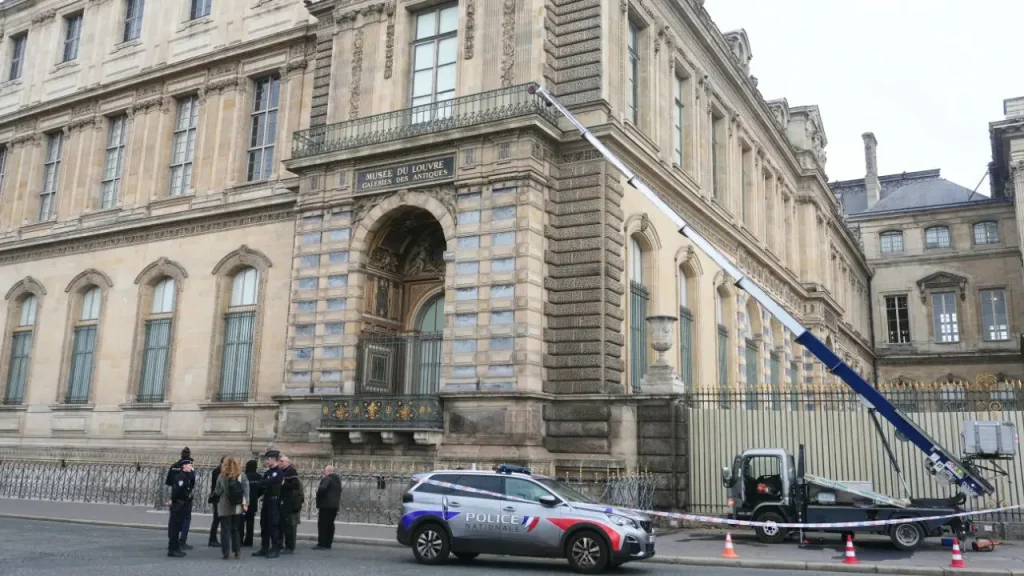The Great Louvre Heist: A Bold Museum Robbery That Shocked France
In a daring robbery reminiscent of a Hollywood thriller, thieves orchestrated a sophisticated heist at the world-famous Louvre Museum in Paris, making off with priceless royal jewelry in an operation that took less than four minutes. Paris prosecutor Laure Beccuau revealed that the criminals employed an ingenious method to gain access to the museum’s treasures – they used a professional furniture-moving lift to reach the second floor of the iconic building. The operation began with the thieves posing as customers looking to hire a freight lift for a moving job. When the equipment owner arrived to confirm the booking, the suspects threatened this individual, forcing them to surrender the equipment and leave. This carefully planned deception gave the thieves the perfect tool to execute their audacious plan, allowing them to position the vehicle alongside the Seine-facing façade of the museum.
The lightning-fast robbery has sent shockwaves through France, with some officials comparing the national trauma to the 2019 Notre-Dame cathedral fire. Once inside, the thieves smashed display cases and methodically selected their targets – eight exquisite objects of immense historical and monetary value. Among the stolen items were a sapphire diadem, necklace, and earring associated with 19th-century queens Marie-Amélie and Hortense. The haul also included an emerald necklace and earrings that once belonged to Empress Marie-Louise, Napoleon Bonaparte’s second wife, along with a reliquary brooch. The imperial ensemble of Empress Eugénie was not spared either – her diamond diadem and large corsage-bow brooch, pieces of exceptional craftsmanship, were also taken. Curiously, one piece – Empress Eugénie’s emerald-set imperial crown containing more than 1,300 diamonds – was later discovered outside the museum, damaged but recoverable.
The scale of the theft is staggering, with Beccuau valuing the stolen items at approximately $102.1 million. Given the significance of the case, the investigation team has expanded to include 100 people working tirelessly to track down the perpetrators and recover the national treasures. In a detail that has raised eyebrows, it was revealed that the stolen pieces were not insured – a common situation for state collections due to prohibitive insurance costs. According to France’s culture ministry, the state typically “acts as its own insurer” for works in their usual place of conservation, citing the generally low rate of accidents and the extreme expense of insuring such valuable artifacts. This self-insurance approach, while financially pragmatic, now leaves the French government to bear the full financial impact of the losses.
Investigators are pursuing several theories about the motivation behind the heist, with Beccuau suggesting the robbery could be linked to organized crime. One hypothesis is that the thieves may have been working on commission for a wealthy collector who specifically wanted these historical pieces. This scenario offers some hope that the items would be preserved intact, albeit hidden away in a private collection. The alternative theory is more concerning – that the thieves were motivated purely by the material value of the jewels and precious metals, which could mean the pieces might be broken down and the gems and gold sold separately, destroying their historical significance and artistic integrity forever. Beccuau also raised the possibility that the stolen items could be used in money laundering operations, particularly in connection with drug trafficking, noting that “nowadays, anything can be linked to drug trafficking, given the significant sums of money obtained from drug trafficking.”
The investigation has yielded some promising leads, with prosecutors revealing that a vest, a bottle of liquid, and other equipment abandoned at the scene are now being examined for forensic evidence. While authorities are exploring all possible avenues, foreign interference has reportedly been largely ruled out as a factor in the robbery. The location of the theft within the museum is also noteworthy – the heist took place just 270 yards from where the “Mona Lisa,” perhaps the world’s most famous painting, is displayed. This proximity to such a well-guarded masterpiece highlights both the audacity of the thieves and raises questions about security protocols throughout the museum.
Despite the shocking robbery, the Louvre has demonstrated remarkable resilience. The museum reopened its doors to the public on Wednesday morning, welcoming crowds beneath its iconic glass pyramid just days after the heist. The swift return to normal operations signals the institution’s determination to move forward while the investigation continues in the background. This robbery has not only resulted in the loss of irreplaceable historical artifacts but has also prompted a national conversation about the security of France’s cultural heritage. As investigators work to solve the case and recover the stolen treasures, the heist serves as a sobering reminder of the continuing vulnerability of even the world’s most prestigious museums to determined criminals. The coming weeks will be crucial as authorities race to find the perpetrators before the priceless historical jewelry potentially disappears forever into the shadowy world of illegal art and antiquities.


